Ambient to Elevated Temperature: Ecotribology of Water-Based Lubricants Incorporating hBN/TiO2 Nanoadditives
Abstract
1. Introduction
2. Materials and Methods
2.1. Materials
| Materials | C | Si | Mn | Mo | Ni | Cr | Cu | P + S | Nb + V + Ti |
|---|---|---|---|---|---|---|---|---|---|
| Disk | 0.16 | 0.25 | 1.5 | 0.007 | 0.006 | 0.02 | - | 0.019 | <0.02 |
| Ball | 1.0 | 0.25 | 0.35 | 0.10 | - | 1.5 | 0.03 | <0.03 | - |
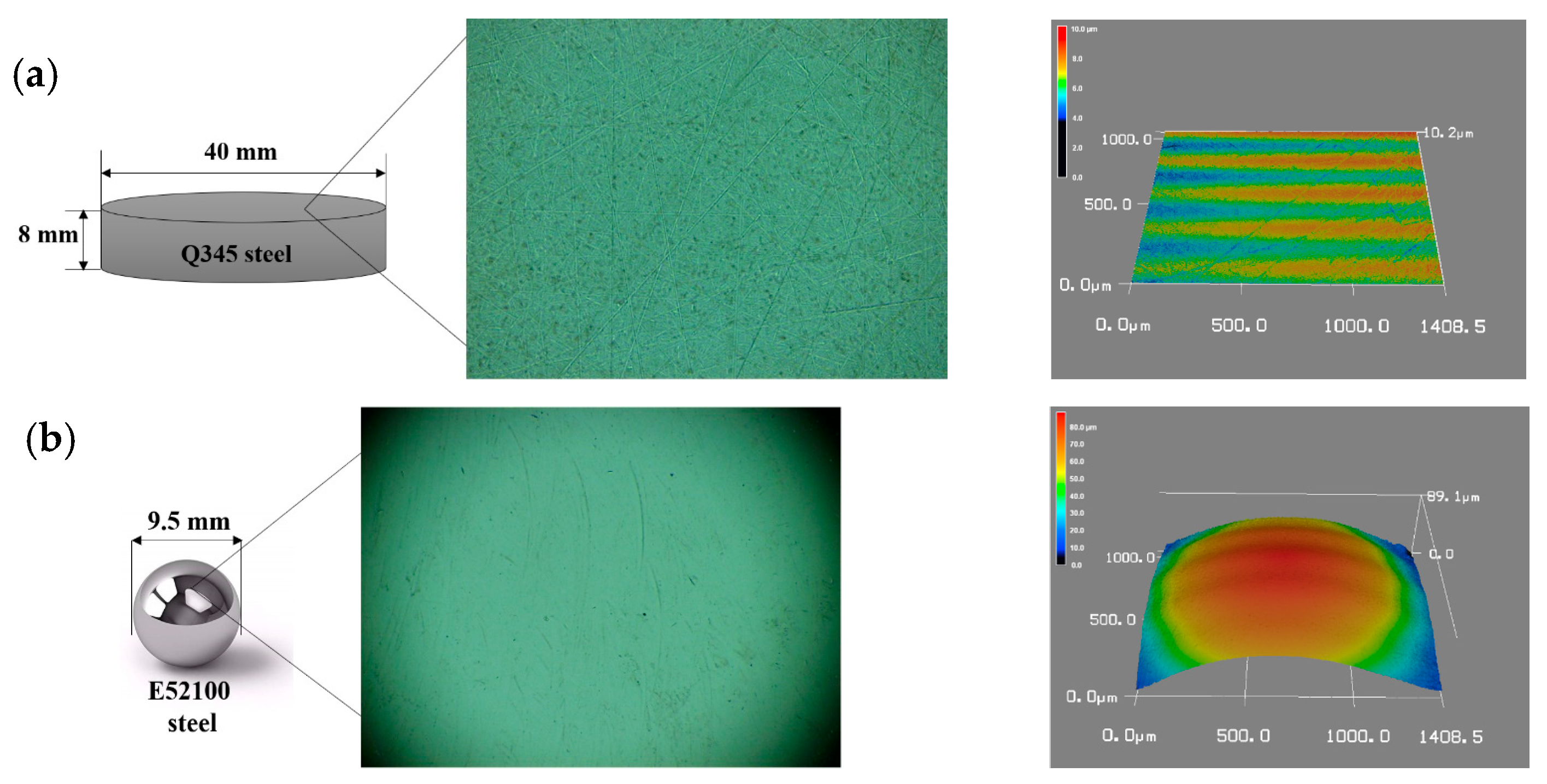
2.2. Lubricant Preparation
2.3. Tribological Tests
2.4. Appraisal Techniques
3. Results
3.1. Nanoparticle Characterisation
3.2. COF
3.3. Wear of Disk
3.4. Wear of Ball
4. Discussions
4.1. Wettability
4.2. Lubrication Mechanism at 25 °C
4.3. Lubrication Mechanism at 500 °C
5. Conclusions
Supplementary Materials
Author Contributions
Funding
Data Availability Statement
Acknowledgments
Conflicts of Interest
References
- Barnosky, A.D.; Hadly, E.A.; Bascompte, J.; Berlow, E.L.; Brown, J.H.; Fortelius, M.; Getz, W.M.; Harte, J.; Hastings, A.; Marquet, P.A. Approaching a state shift in Earth’s biosphere. Nature 2012, 486, 52–58. [Google Scholar] [CrossRef]
- Barnosky, A.D.; Matzke, N.; Tomiya, S.; Wogan, G.O.; Swartz, B.; Quental, T.B.; Marshall, C.; McGuire, J.L.; Lindsey, E.L.; Maguire, K.C. Has the Earth’s sixth mass extinction already arrived? Nature 2011, 471, 51–57. [Google Scholar] [CrossRef]
- Glenn, J.C.; Gordon, T.J.; Florescu, E. 2013-14 State of the Future; The Millennium Project: Washington, DC, USA, 2014. [Google Scholar]
- Bartz, W.J. Ecotribology: Environmentally acceptable tribological practices. Tribol. Int. 2006, 39, 728–733. [Google Scholar] [CrossRef]
- Sasaki, S. Environmentally friendly tribology (Eco-tribology). J. Mech. Sci. Technol. 2010, 24, 67–71. [Google Scholar] [CrossRef]
- Gebeshuber, I.C. Ecotribology: Development, Prospects, and Challenges. In Ecotribology: Research Developments; Davim, J.P., Ed.; Springer International Publishing: Cham, Switzerland, 2016; pp. 1–39. [Google Scholar]
- Stojilković, M.; Golubović, D.; Ješić, D. Ecotribology aspects in the lubricants application. EXPRES 2014, 2014, 124. [Google Scholar]
- Shi, S.-C.; Huang, T.-F. Self-Healing Materials for Ecotribology. Materials 2017, 10, 91. [Google Scholar] [CrossRef] [PubMed]
- Zhu, S.; Cheng, J.; Qiao, Z.; Yang, J. High temperature solid-lubricating materials: A review. Tribol. Int. 2019, 133, 206–223. [Google Scholar] [CrossRef]
- Erdemir, A. A crystal-chemical approach to lubrication by solid oxides. Tribol. Lett. 2000, 8, 97–102. [Google Scholar] [CrossRef]
- Semenov, A.P. Tribology at high temperatures. Tribol. Int. 1995, 28, 45–50. [Google Scholar] [CrossRef]
- Dohda, K.; Boher, C.; Rezai-Aria, F.; Mahayotsanun, N. Tribology in metal forming at elevated temperatures. Friction 2015, 3, 1–27. [Google Scholar] [CrossRef]
- Wan, S.; Tieu, A.K.; Xia, Y.; Zhu, H.; Tran, B.H.; Cui, S. An overview of inorganic polymer as potential lubricant additive for high temperature tribology. Tribol. Int. 2016, 102, 620–635. [Google Scholar] [CrossRef]
- Zulkifli, N.W.M.; Kalam, M.A.; Masjuki, H.H.; Al Mahmud, K.A.H.; Yunus, R. The Effect of Temperature on Tribological Properties of Chemically Modified Bio-Based Lubricant. Tribol. Trans. 2014, 57, 408–415. [Google Scholar] [CrossRef]
- Duntu, S.H.; Ahmad, I.; Islam, M.; Boakye-Yiadom, S. Effect of graphene and zirconia on microstructure and tribological behaviour of alumina matrix nanocomposites. Wear 2019, 438–439, 203067. [Google Scholar] [CrossRef]
- Ürdem, Ş.; Duru, E.; Algül, H.; Uysal, M.; Akbulut, H. Evaluation of high temperature tribological behavior of electroless deposited NiB–Al2O3 coating. Wear 2021, 482–483, 203960. [Google Scholar] [CrossRef]
- Tomala, A.; Hernandez, S.; Rodriguez Ripoll, M.; Badisch, E.; Prakash, B. Tribological performance of some solid lubricants for hot forming through laboratory simulative tests. Tribol. Int. 2014, 74, 164–173. [Google Scholar] [CrossRef]
- Zhao, J.; Yang, G.; Zhang, C.; Zhang, Y.; Zhang, S.; Zhang, P. Synthesis of water-soluble Cu nanoparticles and evaluation of their tribological properties and thermal conductivity as a water-based additive. Friction 2019, 7, 246–259. [Google Scholar] [CrossRef]
- Zhang, C.; Zhang, S.; Song, S.; Yang, G.; Yu, L.; Wu, Z.; Li, X.; Zhang, P. Preparation and Tribological Properties of Surface-Capped Copper Nanoparticle as a Water-Based Lubricant Additive. Tribol. Lett. 2014, 54, 25–33. [Google Scholar] [CrossRef]
- He, A.; Huang, S.; Yun, J.-H.; Wu, H.; Jiang, Z.; Stokes, J.; Jiao, S.; Wang, L.; Huang, H. Tribological Performance and Lubrication Mechanism of Alumina Nanoparticle Water-Based Suspensions in Ball-on-Three-Plate Testing. Tribol. Lett. 2017, 65, 40. [Google Scholar] [CrossRef]
- Zhu, Z.X.; Sun, J.L.; Wei, H.R.; Niu, T.L.; Zhu, Z.L. Research on Lubrication Behaviors of Nano-TiO2 in Water-Based Hot Rolling Liquid. Adv. Mater. Res. 2013, 643, 139–143. [Google Scholar]
- Kong, L.; Sun, J.; Bao, Y.; Meng, Y. Effect of TiO2 nanoparticles on wettability and tribological performance of aqueous suspension. Wear 2017, 376–377, 786–791. [Google Scholar] [CrossRef]
- Yanan, M.; Jianlin, S.; Jiaqi, H.; Xudong, Y.; Yu, P. Recycling prospect and sustainable lubrication mechanism of water-based MoS2 nano-lubricant for steel cold rolling process. J. Clean. Prod. 2020, 277, 123991. [Google Scholar] [CrossRef]
- Wang, Y.; Du, Y.; Deng, J.; Wang, Z. Friction reduction of water based lubricant with highly dispersed functional MoS2 nanosheets. Colloids Surf. A Physicochem. Eng. Asp. 2019, 562, 321–328. [Google Scholar] [CrossRef]
- Hu, Y.; Wang, Y.; Wang, C.; Ye, Y.; Zhao, H.; Li, J.; Lu, X.; Mao, C.; Chen, S.; Mao, J.; et al. One-pot pyrolysis preparation of carbon dots as eco-friendly nanoadditives of water-based lubricants. Carbon 2019, 152, 511–520. [Google Scholar] [CrossRef]
- Liang, S.; Shen, Z.; Yi, M.; Liu, L.; Zhang, X.; Ma, S. In-situ exfoliated graphene for high-performance water-based lubricants. Carbon 2016, 96, 1181–1190. [Google Scholar] [CrossRef]
- Jiao, Y.; Liu, S.; Sun, Y.; Yue, W.; Zhang, H. Bioinspired Surface Functionalization of Nanodiamonds for Enhanced Lubrication. Langmuir 2018, 34, 12436–12444. [Google Scholar] [CrossRef] [PubMed]
- Guo, P.; Chen, L.; Wang, J.; Geng, Z.; Lu, Z.; Zhang, G. Enhanced Tribological Performance of Aminated Nano-Silica Modified Graphene Oxide as Water-Based Lubricant Additive. ACS Appl. Nano Mater. 2018, 1, 6444–6453. [Google Scholar] [CrossRef]
- Du, S.; Sun, J.; Wu, P. Preparation, characterization and lubrication performances of graphene oxide-TiO2 nanofluid in rolling strips. Carbon 2018, 140, 338–351. [Google Scholar] [CrossRef]
- Morshed, A.; Wu, H.; Jiang, Z. A Comprehensive Review of Water-Based Nanolubricants. Lubricants 2021, 9, 89. [Google Scholar] [CrossRef]
- Huang, Q.; Guo, Z.; Wu, Z.; Yuan, C. Insight into the tribological performance of polyurethane composites under high temperature water lubrication. Tribol. Int. 2021, 155, 106784. [Google Scholar] [CrossRef]
- Guo, Z.; Xie, X.; Yuan, C.; Bai, X. Study on influence of micro convex textures on tribological performances of UHMWPE material under the water-lubricated conditions. Wear 2019, 426–427, 1327–1335. [Google Scholar] [CrossRef]
- Guo, Z.; Yuan, C.; Liu, A.; Jiang, S. Study on tribological properties of novel biomimetic material for water-lubricated stern tube bearing. Wear 2017, 376–377, 911–919. [Google Scholar] [CrossRef]
- Liang, X.; Guler, S.I.; Gayah, V.V. An equitable traffic signal control scheme at isolated signalized intersections using Connected Vehicle technology. Transp. Res. Part C Emerg. Technol. 2020, 110, 81–97. [Google Scholar] [CrossRef]
- Matsumoto, K.; Izawa, M.; Nakanishi, T.; Tsubouchi, K. Tribological Properties of Water Glass Lubricant for Hot Metalworking. Tribol. Trans. 2009, 52, 553–559. [Google Scholar] [CrossRef]
- Stott, F.H.; Lin, D.S.; Wood, G.C. The structure and mechanism of formation of the ‘glaze’ oxide layers produced on nickel-based alloys during wear at high temperatures. Corros. Sci. 1973, 13, 449–469. [Google Scholar] [CrossRef]
- Stott, F.H. The role of oxidation in the wear of alloys. Tribol. Int. 1998, 31, 61–71. [Google Scholar] [CrossRef]
- Stott, F.H.; Lin, D.S.; Wood, G.C. “Glazes” produced on Nickel-base Alloys during High Temperature Wear. Nat. Phys. Sci. 1973, 242, 75–77. [Google Scholar] [CrossRef]
- Li, L.X.; Peng, D.S.; Liu, J.A.; Liu, Z.Q. An experiment study of the lubrication behavior of graphite in hot compression tests of Ti–6Al–4V alloy. J. Mater. Process. Technol. 2001, 112, 1–5. [Google Scholar] [CrossRef]
- Jianxin, D.; Hui, Z.; Ze, W.; Yunsong, L.; Youqiang, X.; Shipeng, L. Unlubricated friction and wear behaviors of Al2O3/TiC ceramic cutting tool materials from high temperature tribological tests. Int. J. Refract. Met. Hard Mater. 2012, 35, 17–26. [Google Scholar] [CrossRef]
- Brandt, G. Ceramic cutting tools, state of the art and development trends. Mater. Technol. 1999, 14, 17–22. [Google Scholar] [CrossRef]
- Shi, X.L.; Xu, F.M.; Zhang, Z.J.; Dong, Y.L.; Tan, Y.; Wang, L.; Yang, J.M. Mechanical properties of hot-pressed Al2O3/SiC composites. Mater. Sci. Eng. A 2010, 527, 4646–4649. [Google Scholar] [CrossRef]
- Wu, H.; Jia, F.; Zhao, J.; Huang, S.; Wang, L.; Jiao, S.; Huang, H.; Jiang, Z. Effect of water-based nanolubricant containing nano-TiO2 on friction and wear behaviour of chrome steel at ambient and elevated temperatures. Wear 2019, 426–427, 792–804. [Google Scholar] [CrossRef]
- López, G.; Staia, M.H. High-temperature tribological characterization of zirconium nitride coatings. Surf. Coat. Technol. 2005, 200, 2092–2099. [Google Scholar] [CrossRef]
- Han, J.G.; Yoon, J.S.; Kim, H.J.; Song, K. High temperature wear resistance of (TiAl)N films synthesized by cathodic arc plasma deposition. Surf. Coat. Technol. 1996, 86–87, 82–87. [Google Scholar] [CrossRef]
- Ostrovskaya, Y.L.; Strel’nitskij, V.E.; Kuleba, V.I.; Gamulya, G.D. Friction and wear behaviour of hard and superhard coatings at cryogenic temperatures. Tribol. Int. 2001, 34, 255–263. [Google Scholar] [CrossRef]
- Stone, D.S.; Migas, J.; Martini, A.; Smith, T.; Muratore, C.; Voevodin, A.A.; Aouadi, S.M. Adaptive NbN/Ag coatings for high temperature tribological applications. Surf. Coat. Technol. 2012, 206, 4316–4321. [Google Scholar] [CrossRef]
- Aouadi, S.M.; Luster, B.; Kohli, P.; Muratore, C.; Voevodin, A.A. Progress in the development of adaptive nitride-based coatings for high temperature tribological applications. Surf. Coat. Technol. 2009, 204, 962–968. [Google Scholar] [CrossRef]
- Muratore, C.; Voevodin, A.A. Chameleon Coatings: Adaptive Surfaces to Reduce Friction and Wear in Extreme Environments. Annu. Rev. Mater. Res. 2009, 39, 297–324. [Google Scholar] [CrossRef]
- Buchner, B.; Maderthoner, G.; Buchmayr, B. Characterisation of different lubricants concerning the friction coefficient in forging of AA2618. J. Mater. Process. Technol. 2008, 198, 41–47. [Google Scholar] [CrossRef]
- Morshed, A.; Wu, H.; Ren, M.; Xing, Z.; Jiao, S.; Jiang, Z. A Study of Water-Based Nanolubricants Using Hexagonal Boron Nitride (hBN)-Based Nanocomposites as Lubricant Additives. Lubricants 2024, 12, 123. [Google Scholar] [CrossRef]
- Zhao, C.; Chen, Y.K.; Ren, G. A Study of Tribological Properties of Water-Based Ceria Nanofluids. Tribol. Trans. 2013, 56, 275–283. [Google Scholar] [CrossRef]
- Sun, J.; Meng, Y.; Zhang, B. Tribological Behaviors and Lubrication Mechanism of Water-based MoO3 Nanofluid during Cold Rolling Process. J. Manuf. Process. 2021, 61, 518–526. [Google Scholar] [CrossRef]
- Wu, H.; Jia, F.; Li, Z.; Lin, F.; Huo, M.; Huang, S.; Sayyar, S.; Jiao, S.; Huang, H.; Jiang, Z. Novel water-based nanolubricant with superior tribological performance in hot steel rolling. Int. J. Extrem. Manuf. 2020, 2, 025002. [Google Scholar] [CrossRef]
- Morshed, A.; Lin, F.; Wu, H.; Xing, Z.; Jiao, S.; Hasan, M.M.; Jiang, Z. hBN/TiO2 water-based nanolubricants: A solution for stick-slip mitigation in tribological applications. Nanoscale Adv. 2025, 7, 1972–1988. [Google Scholar] [CrossRef]
- Wu, H.; Zhao, J.; Xia, W.; Cheng, X.; He, A.; Yun, J.H.; Wang, L.; Huang, H.; Jiao, S.; Huang, L.; et al. A study of the tribological behaviour of TiO2 nano-additive water-based lubricants. Tribol. Int. 2017, 109, 398–408. [Google Scholar] [CrossRef]
- da Silva, L.J.; D’Oliveira, A.S.C.M. NiCrSiBC coatings: Effect of dilution on microstructure and high temperature tribological behavior. Wear 2016, 350–351, 130–140. [Google Scholar] [CrossRef]
- Torres, H.; Rodríguez Ripoll, M.; Prakash, B. Tribological behaviour of self-lubricating materials at high temperatures. Int. Mater. Rev. 2018, 63, 309–340. [Google Scholar] [CrossRef]
- Agrawal, P.; McHale, G. Leidenfrost Effect and Surface Wettability. In The Surface Wettability Effect on Phase Change; Marengo, M., De Coninck, J., Eds.; Springer International Publishing: Cham, Switzerland, 2022; pp. 189–233. [Google Scholar]
- Baumeister, K.J.; Hamill, T.D.; Schoessow, G.J. A generalized correlation of vaporization times of drops in film boiling on a flat plate. In Proceedings of the International Heat Transfer Conference 3, Chicago, IL, USA, 7–12 August 1966. [Google Scholar]
- Januszkiewicz, K.R.; Riahi, A.R.; Barakat, S. High temperature tribological behaviour of lubricating emulsions. Wear 2004, 256, 1050–1061. [Google Scholar] [CrossRef]
- Bamberger, M.; Jeschar, R.; Prinz, B. Untersuchung des Wärmeübergangs beim Kühlen von Nichteisenmetallen durch Wasser. Int. J. Mater. Res. 1979, 70, 553–560. [Google Scholar] [CrossRef]
- Mizikar, E. Spray cooling investigation for continuous casting of billets and blooms. Iron Steel Engng. 1970, 6, 53–60. [Google Scholar]
- Grissom, W.M.; Wierum, F. Liquid spray cooling of a heated surface. Int. J. Heat Mass Transf. 1981, 24, 261–271. [Google Scholar] [CrossRef]
- Kunihide, M.; Itaru, M. The behavior of a water droplet on heated surfaces. Int. J. Heat Mass Transf. 1984, 27, 781–791. [Google Scholar] [CrossRef]
- Senda, J. Experimental studies on the behavior of a small droplet impinging upon a hot surface. ICLASS-82 1982, 397. https://cir.nii.ac.jp/crid/1573105974496862208.
- Kwon, M.J.; Park, I.S. Numerical Study of the Effect of Nozzle Arrangement on Cooling Process in Running Hot Steel Strip after Hot Rolling. ISIJ Int. 2013, 53, 1042–1046. [Google Scholar] [CrossRef][Green Version]
- Zabala, B.; Igartua, A.; Scarpis, V.; Timelli, G.; Girot, F.; Nevshupa, R. Multiparametric study of Leidenfrost point and wettability of lubricants on high-pressure die-casting dies. Int. J. Therm. Sci. 2018, 125, 66–73. [Google Scholar] [CrossRef]
- Wang, Y.; Zhang, L.; Liu, A.; Wu, C.; Li, W. Tribological performance of silicone oil based Al2O3 nano lubricant for an Mg alloy subjected to sliding at elevated temperatures. Tribol. Int. 2022, 175, 107779. [Google Scholar] [CrossRef]
- Bancroft, G.M.; Kasrai, M.; Fuller, M.; Yin, Z.; Fyfe, K.; Tan, K.H. Mechanisms of tribochemical film formation: Stability of tribo- and thermally-generated ZDDP films. Tribol. Lett. 1997, 3, 47–51. [Google Scholar] [CrossRef]
- Neville, A.; Morina, A.; Haque, T.; Voong, M. Compatibility between tribological surfaces and lubricant additives-How friction and wear reduction can be controlled by surface/lube synergies. Tribol. Int. 2007, 40, 1680–1695. [Google Scholar] [CrossRef]
- Birol, Y. In situ processing of TiCp-Al composites by reacting graphite with AI-Ti melts. J. Mater. Sci. 1999, 34, 1653–1657. [Google Scholar] [CrossRef]
- Wu, C.; Zhang, L.; Qu, P.; Li, S.; Jiang, Z.; Wang, Y. Effects of lubrication and temperature on the tribological behavior of a magnesium alloy under contact sliding. In IOP Conference Series: Materials Science and Engineering, Proceedings of the International Deep-Drawing Research Group (IDDRG 2020), 26–30 October 2020, Seoul, South Korea; IOP Publishing: Bristol, UK, 2020; p. 012018. [Google Scholar]
- Paramsothy, M.; Chan, J.; Kwok, R.; Gupta, M. Al2O3 Nanoparticle Addition to Commercial Magnesium Alloys: Multiple Beneficial Effects. Nanomaterials 2012, 2, 147–162. [Google Scholar] [CrossRef]
- Peterson, M.B.; Murray, S.F.; Florek, J.J. Consideration of Lubricants for Temperatures above 1000 F. A S L E Trans. 1959, 2, 225–234. [Google Scholar] [CrossRef]
- Sliney, H.E. Solid lubricant materials for high temperatures—A review. Tribol. Int. 1982, 15, 303–315. [Google Scholar] [CrossRef]
- Allam, I. Solid lubricants for applications at elevated temperatures: A review. J. Mater. Sci. 1991, 26, 3977–3984. [Google Scholar] [CrossRef]
- Gu, Y.; Jérôme, F. Glycerol as a sustainable solvent for green chemistry. Green Chem. 2010, 12, 1127–1138. [Google Scholar] [CrossRef]
- Kemicalinfo Chemical Industry Information. Sodium Dodecylbenzene Sulfonate–C18H29SO3Na. Available online: https://kemicalinfo.com/chemicals/sodium-dodecylbenzene-sulfonate-c18h29so3na/ (accessed on 20 June 2025).
- Jerome, S.; Ravisankar, B.; Kumar Mahato, P.; Natarajan, S. Synthesis and evaluation of mechanical and high temperature tribological properties of in-situ Al–TiC composites. Tribol. Int. 2010, 43, 2029–2036. [Google Scholar] [CrossRef]
- Heredia-Cancino, J.A.; Ramezani, M.; Álvarez-Ramos, M.E. Effect of degradation on tribological performance of engine lubricants at elevated temperatures. Tribol. Int. 2018, 124, 230–237. [Google Scholar] [CrossRef]
- Jiang, J.; Stott, F.; Stack, M. The role of triboparticulates in dry sliding wear. Tribol. Int. 1998, 31, 245–256. [Google Scholar] [CrossRef]
- Rajput, S.S.; Gangopadhyay, S.; Yaqub, T.B.; Cavaleiro, A.; Fernandes, F. Room and high temperature tribological performance of CrAlN(Ag) coatings: The influence of Ag additions. Surf. Coat. Technol. 2022, 450, 129011. [Google Scholar] [CrossRef]
- Ye, F.; Lou, Z.; Wang, Y.; Liu, W. Wear mechanism of Ag as solid lubricant for wide range temperature application in micro-beam plasma cladded Ni60 coatings. Tribol. Int. 2022, 167, 107402. [Google Scholar] [CrossRef]
- Jiang, J.; Stott, F.; Stack, M. A mathematical model for sliding wear of metals at elevated temperatures. Wear 1995, 181, 20–31. [Google Scholar] [CrossRef]
- Woydt, M.; Habig, K.H. High temperature tribology of ceramics. Tribol. Int. 1989, 22, 75–88. [Google Scholar] [CrossRef]
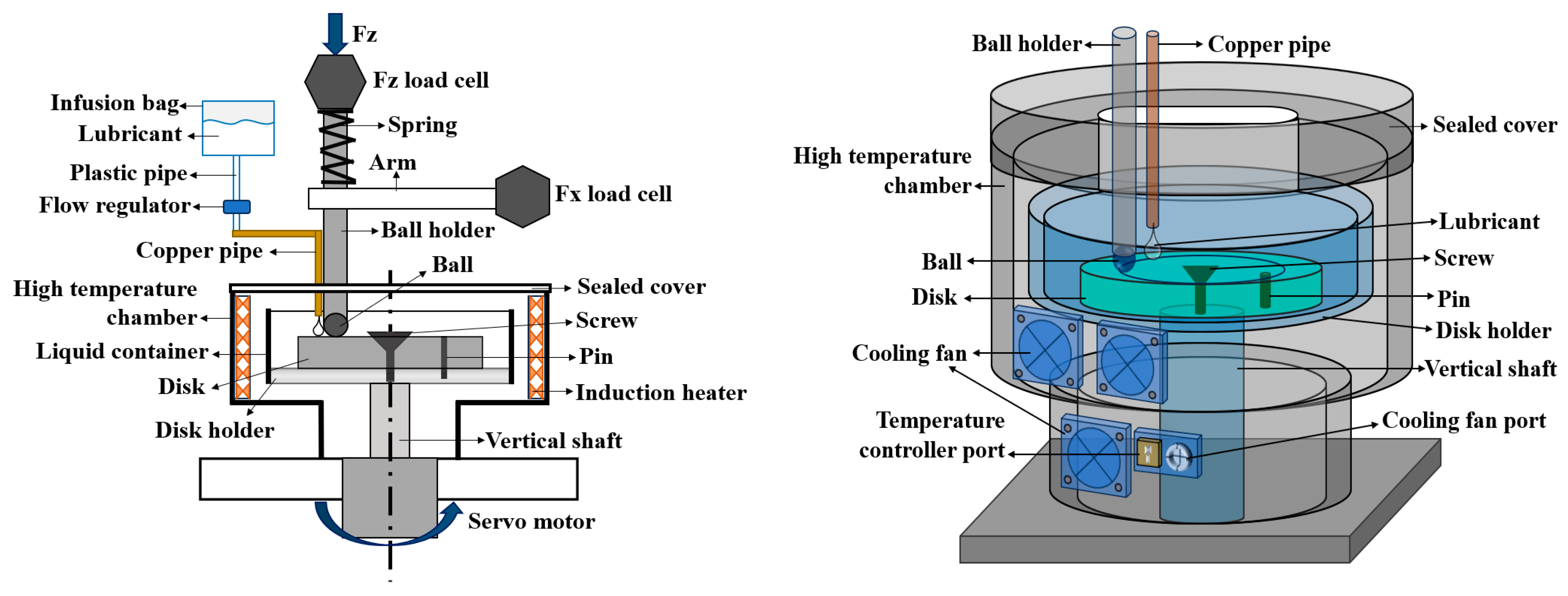


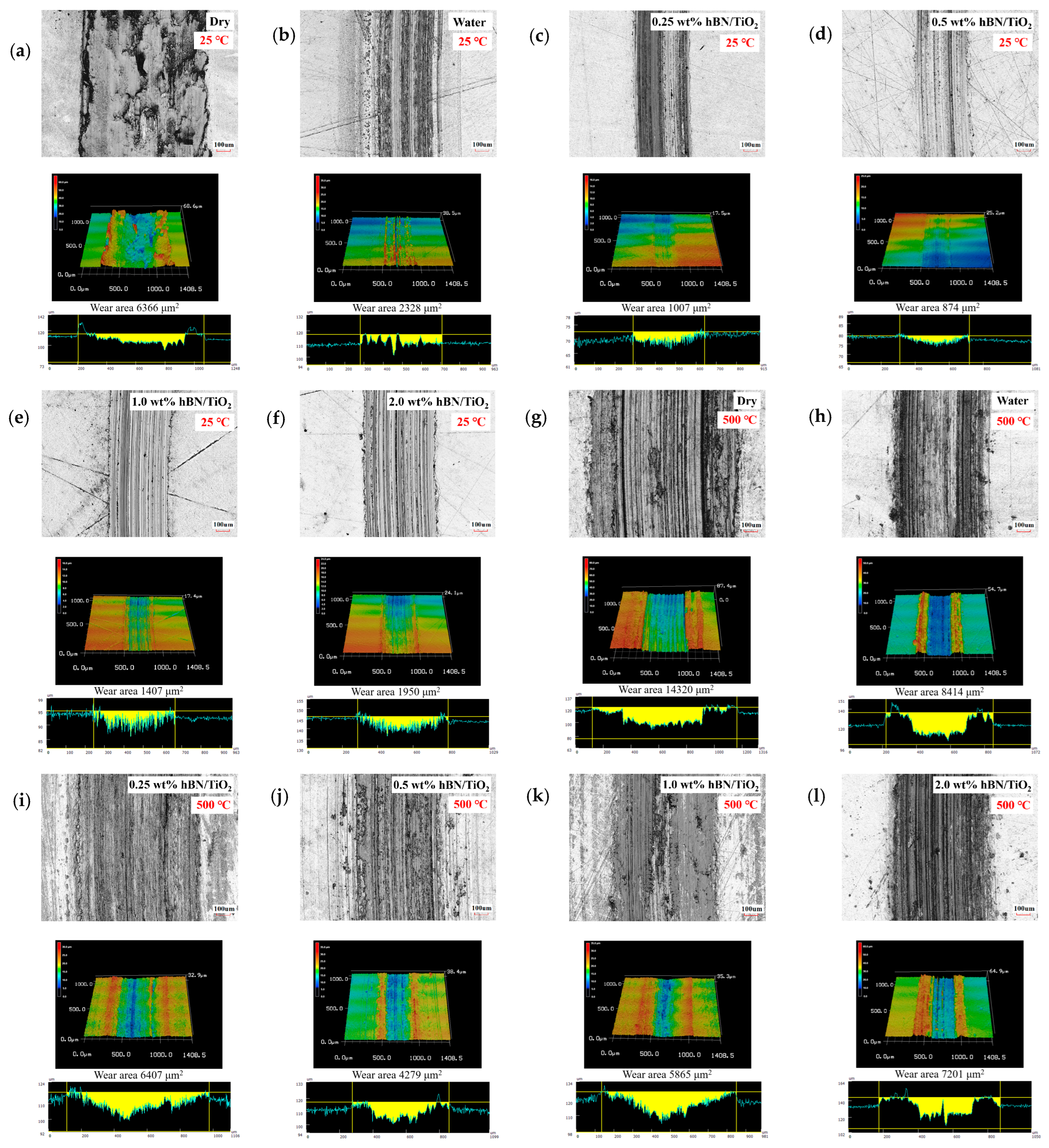
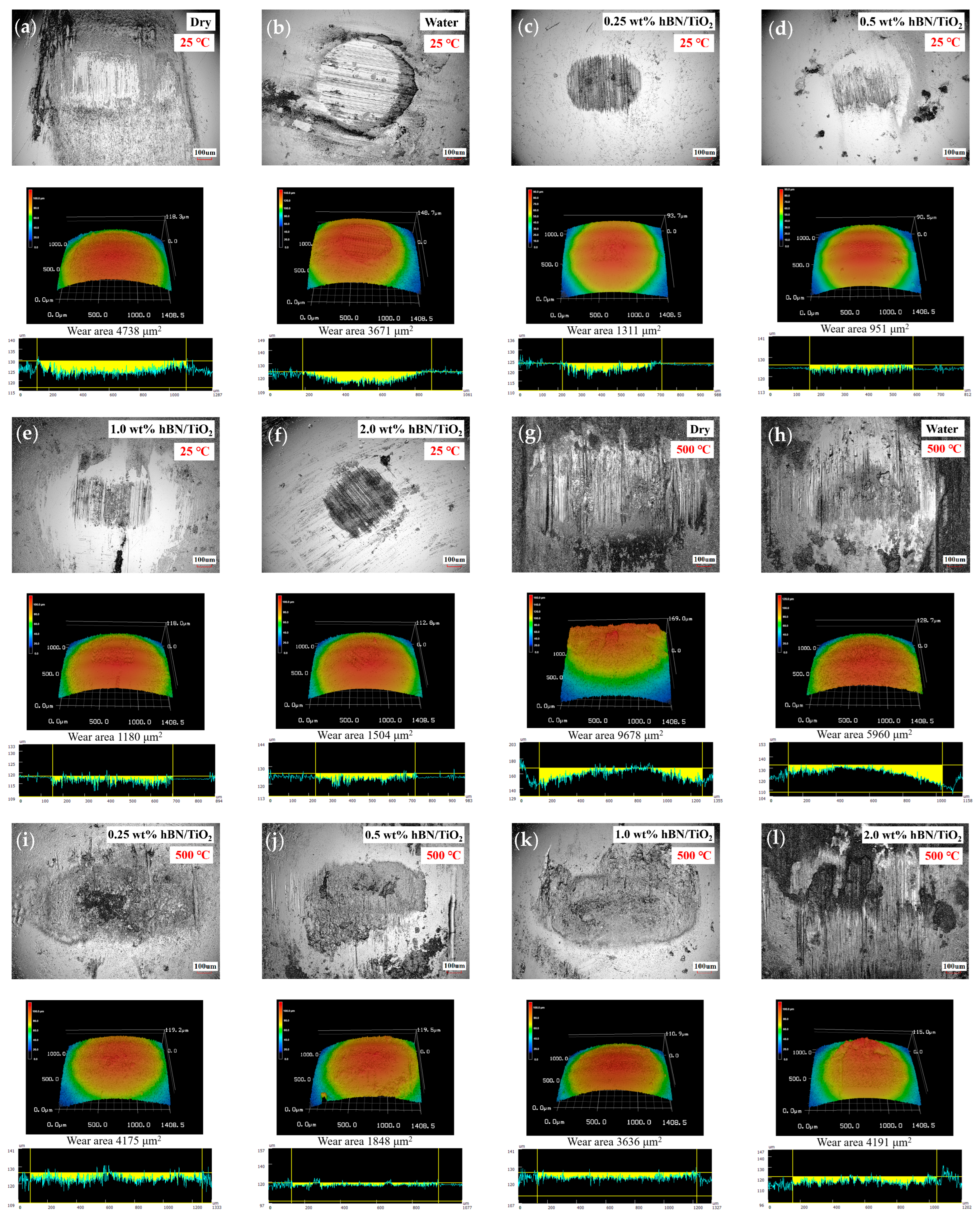

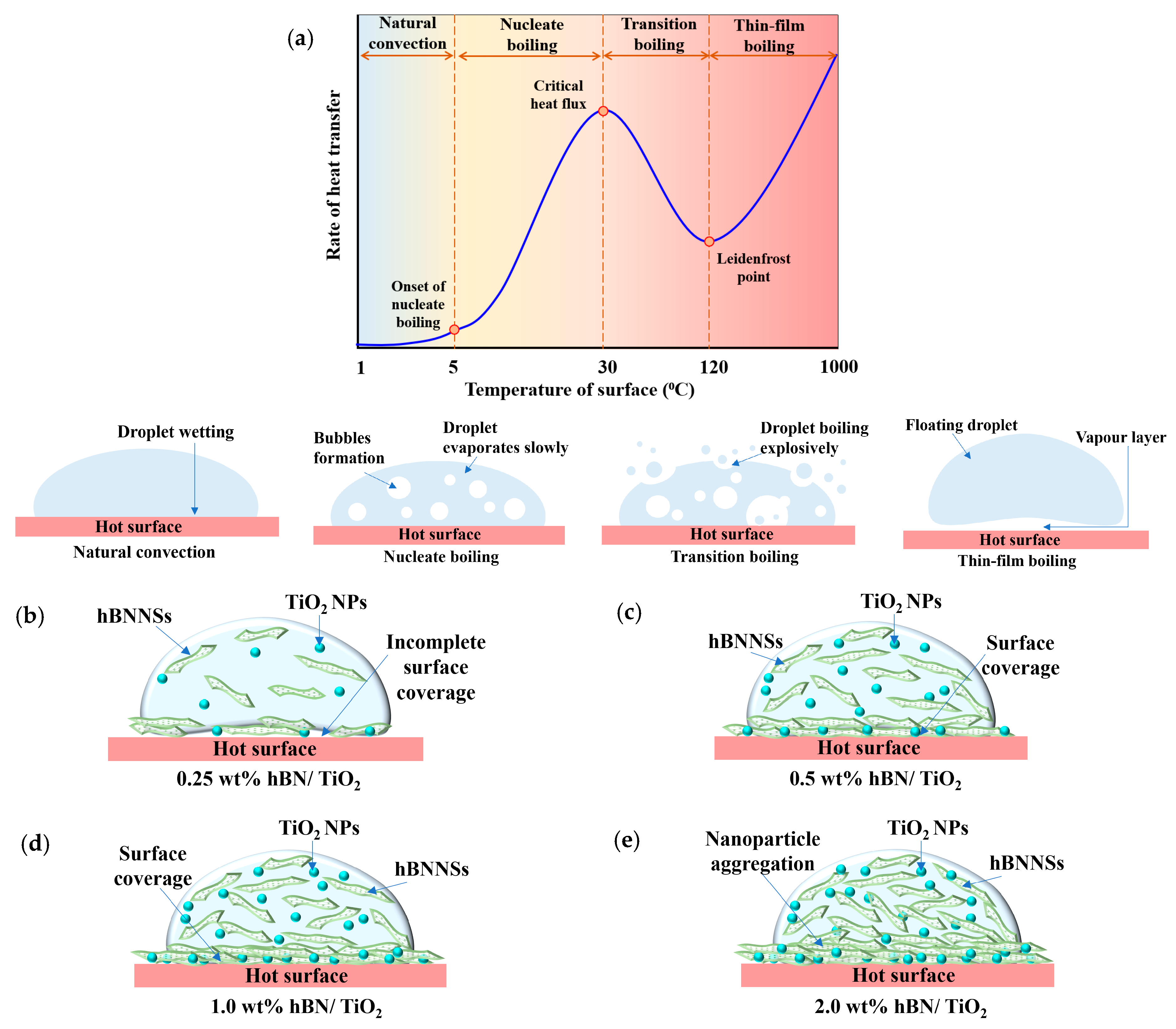
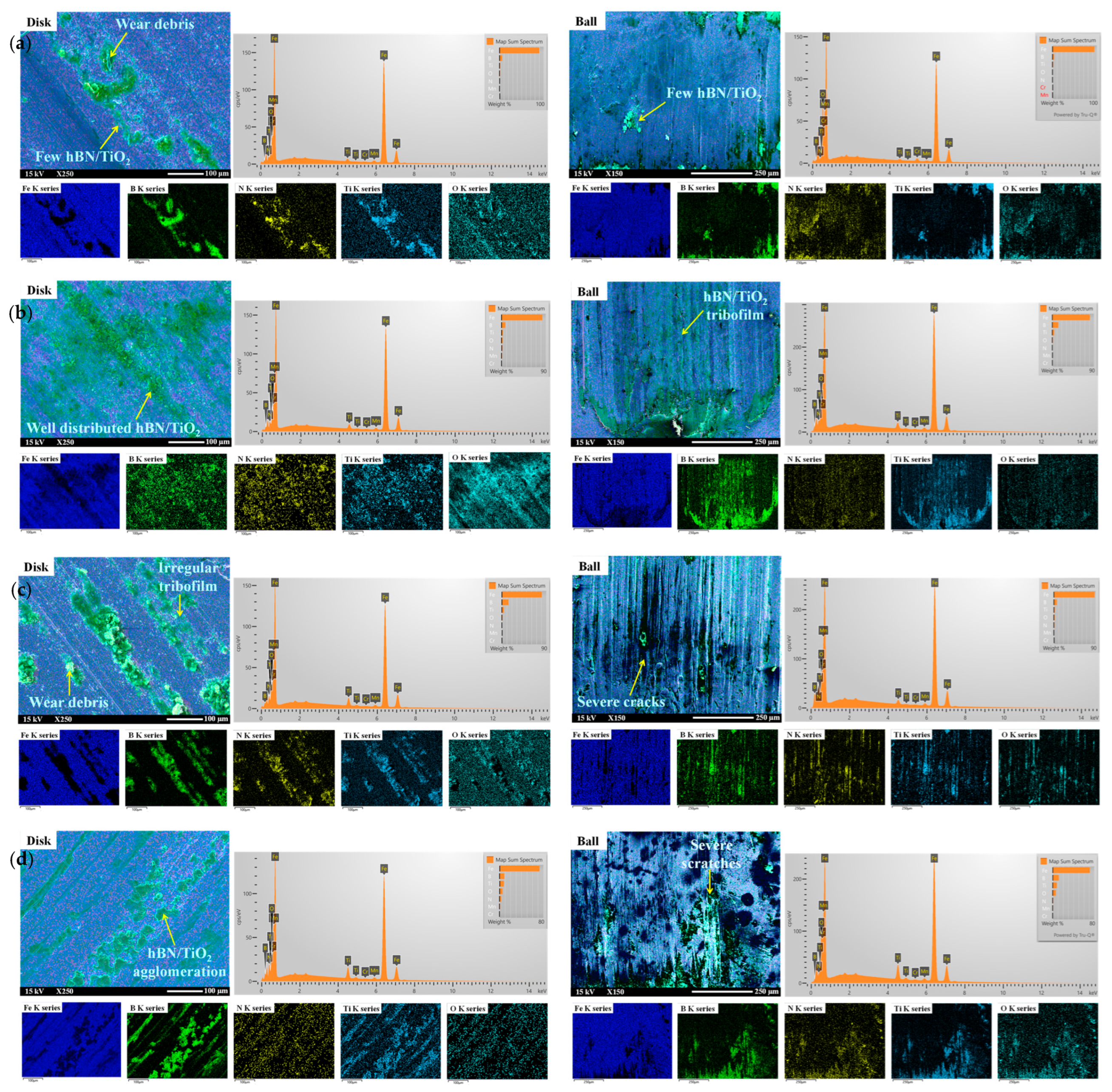
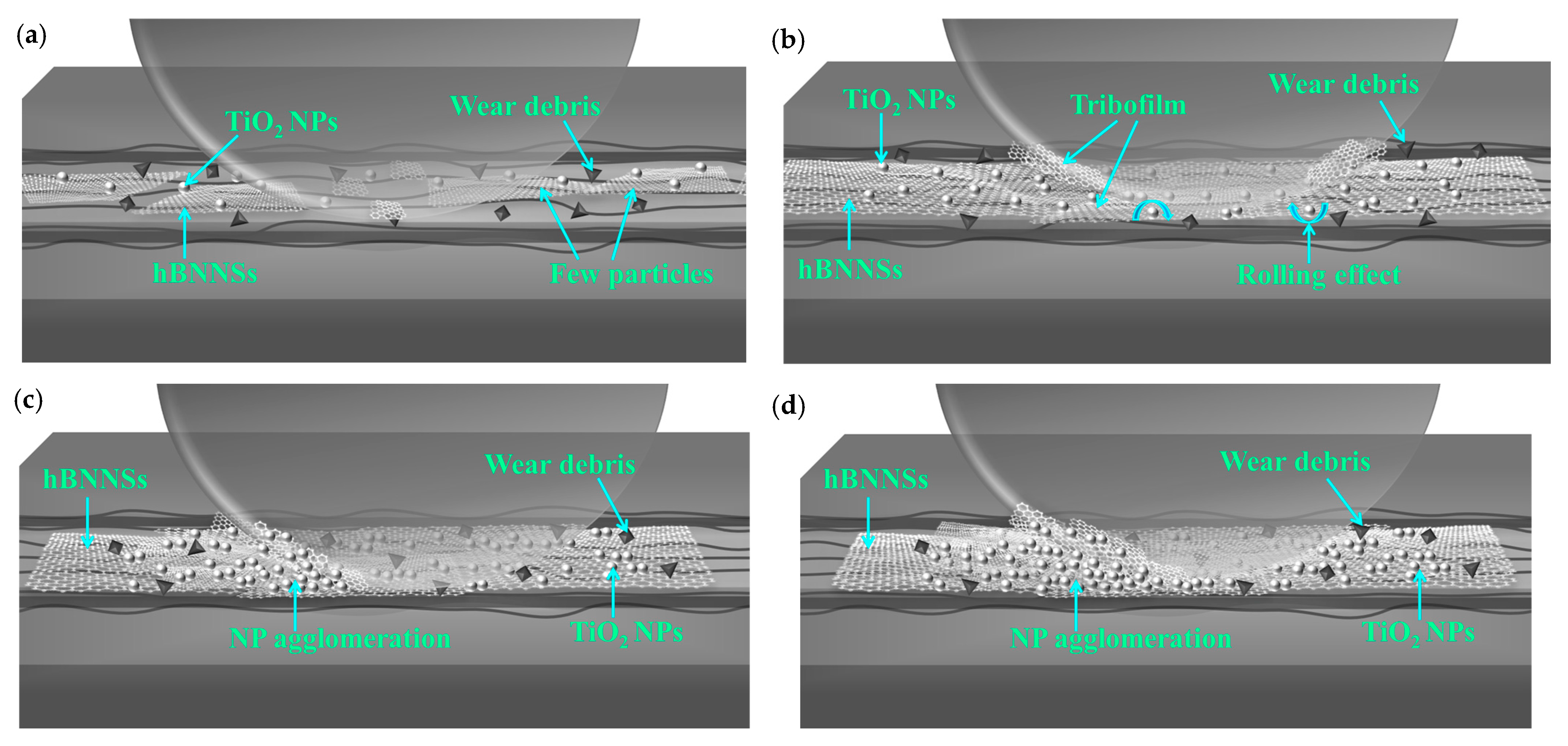


| Lubrication Type | Description |
|---|---|
| L1 | Dry |
| L2 | Water |
| L3 | 0.25 wt% hBN + 0.25 wt% TiO2 + 10.0 wt% Glycerol + 0.2 wt% SDBS |
| L4 | 0.5 wt% hBN + 0.5 wt% TiO2 + 10.0 wt% Glycerol + 0.2 wt% SDBS |
| L5 | 1.0 wt% hBN + 1.0 wt% TiO2 + 10.0 wt% Glycerol + 0.2 wt% SDBS |
| L6 | 2.0 wt% hBN + 2.0 wt% TiO2 + 10.0 wt% Glycerol + 0.2 wt% SDBS |
Disclaimer/Publisher’s Note: The statements, opinions and data contained in all publications are solely those of the individual author(s) and contributor(s) and not of MDPI and/or the editor(s). MDPI and/or the editor(s) disclaim responsibility for any injury to people or property resulting from any ideas, methods, instructions or products referred to in the content. |
© 2025 by the authors. Licensee MDPI, Basel, Switzerland. This article is an open access article distributed under the terms and conditions of the Creative Commons Attribution (CC BY) license (https://creativecommons.org/licenses/by/4.0/).
Share and Cite
Morshed, A.; Lin, F.; Wu, H.; Xing, Z.; Jiao, S.; Jiang, Z. Ambient to Elevated Temperature: Ecotribology of Water-Based Lubricants Incorporating hBN/TiO2 Nanoadditives. Lubricants 2025, 13, 344. https://doi.org/10.3390/lubricants13080344
Morshed A, Lin F, Wu H, Xing Z, Jiao S, Jiang Z. Ambient to Elevated Temperature: Ecotribology of Water-Based Lubricants Incorporating hBN/TiO2 Nanoadditives. Lubricants. 2025; 13(8):344. https://doi.org/10.3390/lubricants13080344
Chicago/Turabian StyleMorshed, Afshana, Fei Lin, Hui Wu, Zhao Xing, Sihai Jiao, and Zhengyi Jiang. 2025. "Ambient to Elevated Temperature: Ecotribology of Water-Based Lubricants Incorporating hBN/TiO2 Nanoadditives" Lubricants 13, no. 8: 344. https://doi.org/10.3390/lubricants13080344
APA StyleMorshed, A., Lin, F., Wu, H., Xing, Z., Jiao, S., & Jiang, Z. (2025). Ambient to Elevated Temperature: Ecotribology of Water-Based Lubricants Incorporating hBN/TiO2 Nanoadditives. Lubricants, 13(8), 344. https://doi.org/10.3390/lubricants13080344










